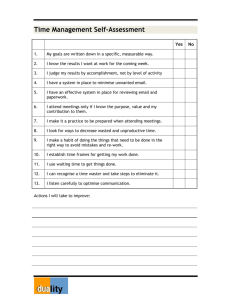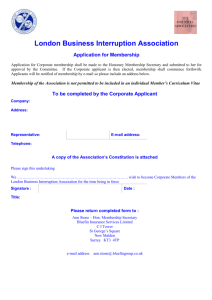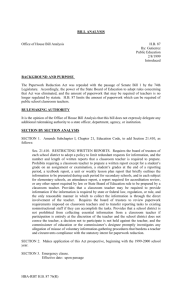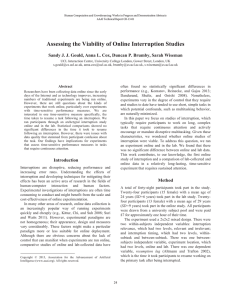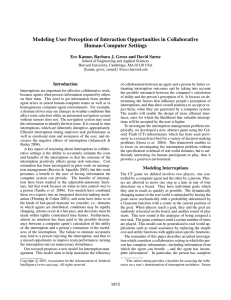Time Management
advertisement
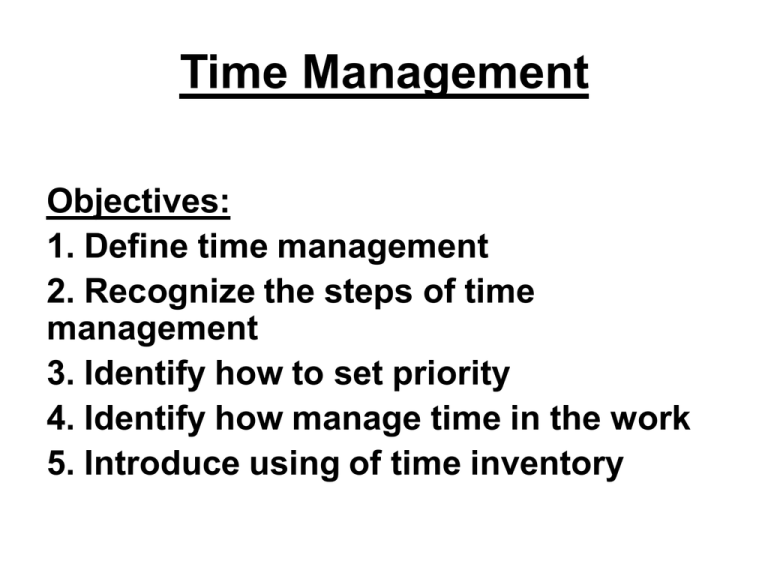
Time Management Objectives: 1. Define time management 2. Recognize the steps of time management 3. Identify how to set priority 4. Identify how manage time in the work 5. Introduce using of time inventory Introduction -(Too much to do & not enough time to do it, it's rampant) -Time is important resource, so managers are to direct employees; effectively they must able to do this for time. -Time management: Is making optimal use of available time. -There is a close relationship between time management & stress (it's reduce stress & increase productivity) Skills needed *Leadership skills:1. Assist follower in working cooperatively. 2. Present interruption that prevents effective time. 3. Role models flexibility in working cooperative. 4. Present calm during periods of high activity. *Management Function:1. Day – to day planning to meet short term & long goals. 2. Build time for planning into the work schedule. 3. Analyze manage of time in unit level using job-analyzes. 4. Eliminate environmental barriers. 5. Good handles paperwork & neat work. 6. Break long task into smaller. Time management steps 1. Allow time for planning & establish priorities (setting aside time at beginning of each day). 2. Complete highest priority task & finish one task before beginning others. 3. Reprioritize the tasks to be accomplished based on information received. Adage Management by efficiency rather than by crisis Vacaroo (2001) suggests (5) priority setting traps: 1. What ever hits first 2. The path of least resistance 3. The squeaky wheel (the individual falls prey to those who are most vocal about their urgent requests). 4. Default (the individual obligated to take on tasks that no one else has come forward to do). 5. Inspiration (individual wait until they become inspired to accomplish task) some necessary task will never inspired. One simple means of prioritizing what need to Divide all request into *Don't do [it probably reflect problem that will take care of themselves & outdated, are better accomplished by someone else]. *Do later [item reflect trivial problems or those that do not have immediate deadlines, this may be procrastinated *Do now [it reflect a unit day-to-day operational needs]. Management time at work Unit manager can utilize time include:1. at start of each workday, identify key priority to be accomplished. 2. What action to do. 3. Assess the staff assigned to work with you, assign the work must delegate to staff. 4. Review short & long term plans of unit regularly. 5. Plan from meeting. 6. Allow time at several points throughout day & end of day to assess progress in achieving goals. Taking breaks Are necessary or not………? To allow worker for refresh (physical & mentally), its integral part of individual time & task M. - The longer hour does not necessary produce the desired outcomes. Interruption Who exposed to interruption more in managerial level…..? Lower level manager experience more interruption than higher (because they are more involved in daily planning than higher level so they interact with subordinates) & also they haven't workspace or clerical to filter interruption Lancter identify time wasters Telephone meeting socializing communication lack of feed back incompetence worker poor sys paperwork Time waster External : -For socialization: 1. Don't make yourself accessible (try not to work at nursing station, close your office door, and sit with your back to other for charting). 2. Interrupt (when someone rambling without reach to point, break in & say excuses me. 3. Avoid promote socialization (moving severed comfortable chairs, Candy, dish, posters, coffee). 4. be brief (watch your own long-winded comments & stand up when finished. 5. Use coffee time for socialization. External time waster For paperwork: -Expert in handling it: • Handle at their arrives • Field it according to the date • Keeping correspondence • use of computerization Internal time waster Poor planning Procrastination Failure to establish goals Inability to delegate Inability to say no Management by crisis Open door policy Monochronic & polychronic time management styles Mono: its style prefers to do on thing at time.Mono: began & finish projects on time, have clean & organized desk as result of handling each piece of paperwork, highly structured. Poly: its style prefers to do two or more things simultaneously Poly: people tend to change plan, borrow & lend things frequently, emphasize relationship rather than task Using time inventory Because most people have an inaccurate perception of time they spend on a task or about total time that they are production during the day. A time inventory may provide insight. It's useful to identify patterns of behavior so it must maintain for several days or weeks, & could repeat annually. 5: am …………….. 6: am …................... 7: am ………………. References *Bessie L. Marquis and Carol J. Huston (2006). "Leadership roles and management functions in nursing: theory and application". Fifth edition.lippincott Willams&Wilkins, 191-206
